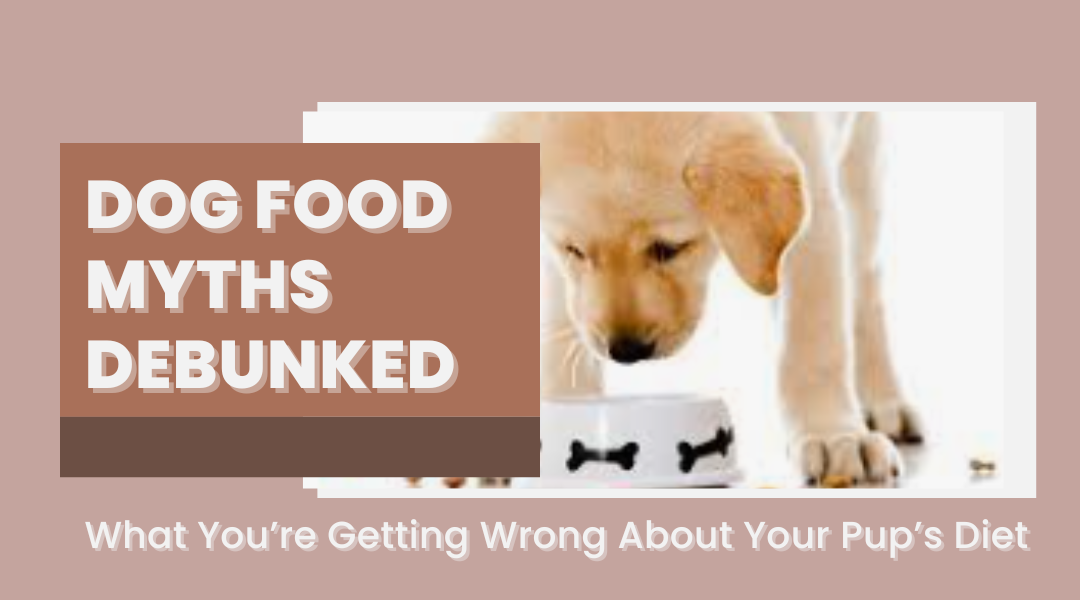Figuring out what to feed your dog these days feels like navigating a minefield. One influencer swears by grain-free kibble, your neighbor insists raw food is the only way to go, and that guy in the pet store claims by-products are basically sawdust. With so much conflicting advice, it’s no wonder pet parents are confused.
But here’s the thing: a lot of what we think we know about dog nutrition is flat-out wrong. And feeding based on myths can do more harm than good. Let’s cut through the noise and set the record straight.
Myth 1: “All Dogs Thrive on the Same Food”
Reality: Your lazy bulldog and your hyperactive border collie shouldn’t be eating the same meal.
Dogs have wildly different needs depending on their age, size, breed, and even lifestyle. A growing puppy needs way more calories and nutrients than a senior dog who’s mostly napping these days. Big breeds like Great Danes need food that supports joint health, while tiny Chihuahuas burn through calories faster than you can say “second breakfast.”
Bottom line? There’s no universal “best” dog food—just the best one for your dog.
Myth 2: “Grains Are Bad for Dogs”
Reality: Unless your dog has a diagnosed grain allergy (which is rare), whole grains are actually good for them.
Thanks to slick marketing, grain-free diets exploded in popularity. But grains like oats, brown rice, and barley provide fiber, energy, and essential nutrients. Some grain-free foods swap grains for starchy fillers like peas or lentils, which have been linked to heart issues in certain breeds.
Unless your vet says otherwise, don’t fear the grain.
Myth 3: “By-Products = Mystery Garbage”
Reality: Liver, kidneys, and other organ meats (often labeled as “by-products”) are nutrient powerhouses.
The term “by-product” sounds sketchy, but it just means parts of the animal we humans don’t typically eat—like organ meats, which are packed with vitamins A, D, and iron. Would you rather your dog eat lean muscle meat only, or get a mix of muscle, liver, and other nutrient-dense bits? Exactly.
(That said, low-quality by-products can be questionable—so always check the source.)
Myth 4: “More Protein = Better”
Reality: Too much protein can strain kidneys, especially in older or less active dogs.
Yes, dogs need protein. But slamming them with 40% protein kibble when they spend 20 hours a day snoozing on the couch? Overkill. Excess protein doesn’t magically turn into muscle—it just gets filtered out by the kidneys. Balance is key.
Myth 5: “A Little Human Food Won’t Hurt”
Reality: A single grape or bite of chocolate can hurt—badly.
We get it: those puppy eyes are hard to resist. But while some human foods (like plain chicken or carrots) are fine, others—like onions, garlic, xylitol (found in gum and peanut butter), and even seemingly harmless grapes—can be deadly. And fatty table scraps? A fast track to pancreatitis.
If you must share, stick to dog-safe options in tiny amounts.
The Truth About Treats and Table Scraps
- Treats aren’t “free” calories. They should make up less than 10% of your dog’s daily intake. Swap out processed biscuits for fresh blueberries or frozen green beans.
- Leftovers = trouble. That greasy pizza crust or buttery mashed potatoes can lead to obesity and digestive disasters.
- Training smarter. Use tiny, low-cal rewards (even their regular kibble works) and mix in praise or play to avoid overfeeding.
How to Decode Dog Food Labels Like a Pro
- First ingredient = main ingredient. Look for real meat (e.g., “chicken,” “beef”) or a named meat meal (like “salmon meal”). Skip vague terms like “meat derivatives.”
- Check the numbers. A balanced diet has moderate protein (20-30%), healthy fats (10-15%), and fiber (3-5%).
- Avoid sketchy preservatives. BHA and BHT are red flags. Natural preservatives like vitamin E are safer.
- Look for AAFCO approval. This ensures the food meets basic nutritional standards.
Final Thought: Feed Smarter, Not Harder
Your dog doesn’t need the trendiest (or most expensive) food—just the right one for them. Ditch the hype, focus on science, and when in doubt, ask your vet. After all, a well-fed dog is a happy, healthy, tail-wagging machine.
